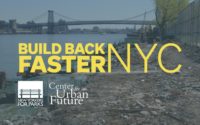By Jonathan Bowles and Adam Ganser
April 22, 2021
The candidates running to be New York City’s next mayor have proposed wise investments to help ensure an inclusive recovery from the COVID crisis, targeting new funds to close the digital divide, bolster the transit system, overhaul NYCHA facilities, build homes for the homeless and protect the environment. But with the city facing long-term fiscal uncertainties, New York also needs ideas for how to save money even as it spends.
One of the best opportunities to do just that, especially as Washington considers authorizing billions of dollars to upgrade infrastructure, is by reforming the city’s deeply flawed process for designing and building capital projects.
Today, building a new branch library can easily take more than seven years to complete and cost more than $1,500 per square foot to construct, roughly triple the cost and time required to build a Class A office building. A recent bathroom project in a public park will cost the city over $4 million.
These are cost inflations New York can no longer afford. The city’s infrastructure needs are simply too great and capital funding too limited.
The city’s public library system alone faces nearly $1 billion in state-of-good-repair needs. The same dynamic is at play across the city’s built environment, where public parks are straining to accommodate a surge in demand for open space amid the pandemic, the city’s bike infrastructure needs a major expansion and a range of public buildings — including cultural institutions and schools — will need to upgrade ventilation systems and boost energy efficiency to meet ambitious climate goals.
The past year has taught us that investing in social infrastructure like parks and libraries will be crucial to the city’s recovery from the COVID crisis. President Biden’s infrastructure plan could deliver a much-needed infusion of funds for these and other projects, but that money won’t go very far unless the city makes fundamental changes to its deeply flawed process for managing capital projects.
A new report from the Center for an Urban Future shows that reforming this process could save the city $800 million over five years. That’s nearly enough money to clear the entire backlog of state-of-good-repair needs across the city’s three library systems, or pay for 150 full-time parks maintenance workers for the next decade, or fund more than 1,300 miles of protected bike lanes.
The City’s Department of Design and Construction (DDC) has shown that progress is possible. The suite of capital reforms it launched in January 2019 have already reduced the average timeline of a capital project from 96 months to 90 months, a promising achievement.
But while things are heading in the right direction, a capital process where the average project still takes 90 months remains badly broken.
To achieve the deeper improvements that are needed, DDC will need a lot more help than it has gotten thus far from other parts of city government that contribute mightily to the inefficiencies in the capital process — including the Office of Management and Budget.
This help is unlikely to materialize without a strong push from the highest levels of City Hall. That’s why the next mayor should commit to wholesale reforms from day one, and back it up by appointing a new deputy mayor for infrastructure who’s empowered to oversee a reform process involving every agency involved in the capital construction process — and to hold them accountable for driving down costs and timelines.
Other actions are needed, too. The next mayor should lobby Albany to reform the state’s procurement law, which mandates the selection of the lowest bidder on capital projects. Despite good intentions, this too often results in an underwhelming pool of contractors and ends up costing the city more money when projects go awry.
Meanwhile, advocates for social infrastructure citywide should not just push for new infrastructure spending, but also for capital reforms that stretch dollars further. That’s why New Yorkers for Parks calls for fixing the capital process in its new Five Point Plan for Parks Equity, alongside recommendations to commit 1% of the city budget for parks maintenance and operations, give parks a more flexible capital budget, and identify dedicated and equitable alternative public funding streams to shore up aging infrastructure.
Reforming the city’s broken capital construction process will help the city realize significant cost savings during a period of protracted fiscal uncertainty and ensure the greatest possible investment in vital social infrastructure.
Bowles is executive director of the Center for an Urban Future. Ganser is executive director of New Yorkers for Parks.
Read the full article online at the New York Daily News.
